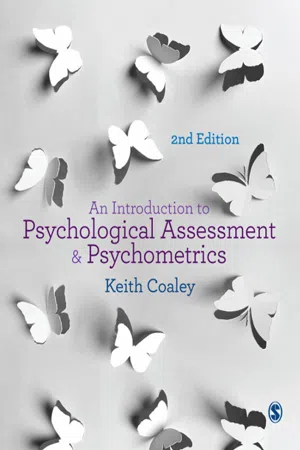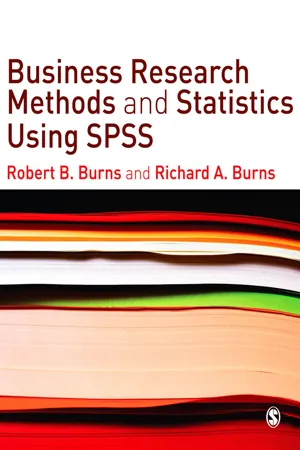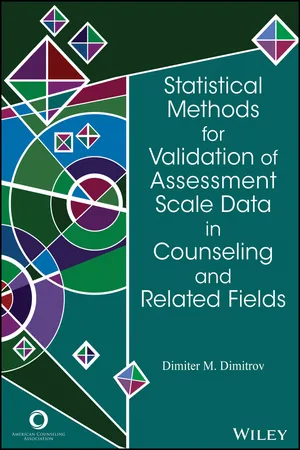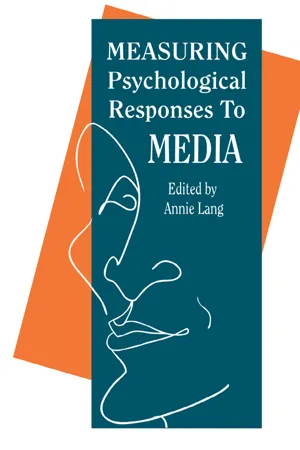Psychology
Semantic Differential Rating Scale
The Semantic Differential Rating Scale is a measurement tool used to assess the meaning of concepts or objects based on the respondent's perceptions. It typically involves a series of bipolar adjectives or phrases, such as "good" and "bad," to capture the range of attitudes or feelings toward the target. This scale provides a structured method for evaluating subjective experiences and attitudes.
Written by Perlego with AI-assistance
Related key terms
Related key terms
1 of 4
Related key terms
1 of 3
6 Key excerpts on "Semantic Differential Rating Scale"
- eBook - ePub
Measurement, Design, and Analysis
An Integrated Approach
- Elazar J. Pedhazur, Liora Pedhazur Schmelkin(Authors)
- 2013(Publication Date)
- Psychology Press(Publisher)
Instead of expressing the total score as a sum of the individual items, it is more useful to express it as an average, that is, dividing the total score by the number of items. Assume, for example, that a measure consists of 20 items and that the response categories range from 1 = disagree very strongly to 6 = agree very strongly. Assume further that a given individual has a total score of 96. It is rather difficult to develop a feel for the meaning of such a total score. Dividing it by 20 (number of items) yields a score of 4.8 on the continuum indicated above, rendering it somewhat easier to interpret.It should, however, be noted that, whether expressed as a total or an average, comparisons of scores on summated scales are relative in nature. Thus, an individual's standing may be compared to his or her group or to some other norm; groups may be compared to each other.Semantic Differential
Stimuli, be they concepts, objects, or people, evoke a variety of responses. The Semantic Differential (SD) technique was developed to assess some such responses. As originally conceived by Osgood (1952) and later expanded upon by Osgood, Suci, and Tannenbaum (1957), the SD4 was meant to assess connotative or metaphorical meaning of a wide range of concepts. Its use is based on two basic notions: (a) that concepts differ (hence can be “differentiated”) with respect to the meaning(s) they convey or evoke, and (b) that the meaning of most concepts can be captured by a relatively small number of dimensions (these are discussed below).4 For convenience, we speak of the SD, but we do not mean to imply that it is a measure. Rather it is a technique of wide applicability.Concepts are rated on a set of bipolar adjective scales. Except for cases where the scale structure is decided upon a priori (see below), typically the goals of using the SD are twofold: (a) to investigate the meaning of the scales by examining relations among them, and (b) to assess the meaning of the concepts or differences among concepts.The format most often used in the SD is illustrated in Table 6.2 , where the concept COMPUTER5 - Keith Coaley(Author)
- 2014(Publication Date)
- SAGE Publications Ltd(Publisher)
Their semantic differential was designed to provide a measurement based upon the meanings people attribute to terms or concepts connected with attitudes. This uses a questionnaire which lists bipolar adjectives such as good–bad, valuable–worthless, enjoyable–unenjoyable, or friendly–unfriendly. Each bipolar pair is linked to a dimension or scale having seven points, with the two ends represented by the contrasting adjectives and the mid-point being a neutral position, like this:Figure 2.3 Scales illustrating the semantic differential approachOsgood et al. devised scales like these in order to study the connotative (personal) meanings that concepts such as ‘sickness,’ ‘sin,’ ‘hatred’ and ‘love’ generate among people. These concepts could then be extended to others which generate attitudes, for example ‘sport,’ ‘politics,’ ‘television’ and so on. Obviously, the choice of bipolar adjectives will depend on the concept being investigated. Many of these will be evaluative and principally indicate a person’s feelings about it. The number of points across the scales can also be varied.Respondents asked to complete the measure will simply be asked to make a mark on the scale points which indicate their attitude. It has been found that even young children, who would have difficulty with Thurstone or Likert scales, are able to respond to the semantic differential (Gahagan, 1987). A person’s overall attitude score is represented by the sum, or possibly the mean, of the scores marked on all the dimensions. The responses to each concept may also be scored on the semantic dimensions (evaluative, potency and activity), and by comparing these for one construct or more, we will gain an understanding of what is called the person’s ‘semantic space’.However, responses which fall at the centre of the scale may be difficult to interpret as these will possibly represent either indifference or ignorance, and further investigation may then be needed to establish the person’s view. In some instances it may also be possible that the individual responds by marking the extreme ends of the scale throughout the measure, regardless of any attitude adopted. This might not become clear unless a number of measures are administered.- Robert P Burns, Richard Burns(Authors)
- 2008(Publication Date)
- SAGE Publications Ltd(Publisher)
good-bad, successful-unsuccessful, beautiful-ugly, cruel-kind, clean-dirty, wise-foolish, honest-dishonest, happy-sad, nice-awful . The same set of scales can be used to rate a variety of different objects (persons, items, events, etc, so that it is possible to make direct comparisons among a person’s attitudes towards smoking, towards politicians, particular products or towards any other set of items whose attitude ratings the researcher is interested in comparing. Different concepts may require slightly different sets of scales for maximum rating precision; ‘kind-cruel’, for example, would probably not work as well as ‘beautiful-ugly’ in measuring attitudes toward modern painting, while we would tend not to use ‘beautiful-ugly’ when rating a political leader although ‘kind-cruel’ might well be a relevant dimension to include. Azjen and Fishbein (1980) use the semantic differential as a means of measuring different parts of an attitude in their theory of reasoned action about consumer behaviour.The reliability and validity of the semantic differential is well documented. A typical layout and instructions for the semantic differential techniques is as follows. Semantic differential scale‘The purpose of this study is to measure the meanings which certain concepts have for you. This is done by having you judge them against a set of descriptive scales which consist of adjectives and their opposites. You are asked to make your judgements on the basis of what these things mean to you. On each page of this booklet, you will find a different concept to be judged and beneath it a set of scales. You are asked to rate the concept on each of the scales in order- eBook - ePub
- Gustav Levine, Stanley Parkinson(Authors)
- 2014(Publication Date)
- Psychology Press(Publisher)
But adjectives suggesting moods (happy, depressed, angry, etc.), can also be used, as in the earlier example that had end points of very unhappy and very happy. Zanna and Cooper (1974) asked subjects to indicate how they felt, “right now,” on a 31-point scale ranging from calm to tense. More often than not, adjectives are employed in a more subtle measurement of attitudes, called the semantic differential (Osgood, Suci, & Tannenbaum, 1957). This approach is an indirect one, as is apparent from the form of the questions. The semantic differential is particularly useful in providing a variety of scale items testing the same attitude. OSGOOD'S SEMANTIC DIFFERENTIAL The full appreciation of the range of scale labels that could be used to express an attitude stems from the introduction of Osgood's semantic differential (Osgood et al., 1957). Charles Osgood and his associates developed this measurement technique while working on a theory of meaning. Their scale consists of the presentation of some concept, say labor unions, or politicians, or the United Nations, followed by a series of scale items, perhaps a half dozen or as many as 20, each bound by bipolar adjectives, and each used to evaluate the same concept. It might look like the scale presented in Fig. 14.1 (although perhaps with more items). In the example in Fig. 14.1 all of the adjectives used to define the poles of the scale items have an underlying dimension in common: an implication of ranging from bad to good. Osgood spoke of adjectives sharing the bad to good implication as representing the evaluative dimension. Each pair of adjectives has other implications besides the bad-good dimension, so the evaluation component is not as clear as in direct rating scales. However, because all of the items share the evaluative dimension, collectively they can offer an attitudinal bottom line - eBook - ePub
- Dimiter M. Dimitrov(Author)
- 2014(Publication Date)
- American Counseling Association(Publisher)
active–passive. These three dimensions of affective meaning were found to be cross-cultural universals in a study of dozens of cultures (Osgood, May, & Miron, 1975).An example of a semantic differential item is shown in Figure 1.2 . Usually the position marked 0 is labeled neutral, the 1 positions are labeled slightly, the 2 positions quite, and the 3 positions extremely (e.g., Heise, 1970).An Example of a Semantic Differential ItemFigure 1.2The semantic differential scale measures both the directionality (e.g., tense vs. relaxed) and intensity (e.g., slight through extreme) of the person's reaction to the respective stimulus. A readable discussion of methodology and scaling related to semantic differential was provided by Heise (1970). As he noted (p. 235), ratings on bipolar adjective scales tend to be correlated, and three basic dimensions of response account for most of the covariation in ratings: Evaluation, Potency, and Activity (EPA). Thus, unlike the unidimensional Likert scales, the semantic differential scale has a three-dimensional (EPA) structure. Prior to combining the item scores into separate factor scores, numerical values (–3, –2, –1, 0, 1, 2, 3) are assigned to the scale positions (see Figure 1.2 ), going from one end of the scale to the other. Then the EPA factor scores (e, p, and a, respectively) can be used separately or to produce a general polarization index, , which indicates the distance from the origin (zero) of the scale and the particular concept under consideration. When the interest is in comparing two concepts (or two groups on the same concept), collectively on all three EPA dimensions, one can use the so-called D score: , where e1 , p1 , and a1 are the factor scores on Evaluation, Potency, and Activity, respectively, for the first concept (or group), and e2 , p2 , and a2 - Annie Lang(Author)
- 2014(Publication Date)
- Routledge(Publisher)
Nominal scales, although not unproblematic (Miller, 1983), enable the signalling of a number of different semantic judgements within a single continuous measurement task, and are easy for most subjects to use. Subjects are required to simply classify moments of the communication event into appropriate categories, or do nothing if none of the categories apply to their evaluation. For example, VOXBOX (Beville, 1985; Higgins, 1982), a commercial ratings research system, had viewers press any of a number of buttons to describe their reaction to any moment or character in a program. The labelled buttons allowed subjects to signal evaluations such as “boring,” “excellent,” or “zap.” In the political communication area, Baggaley (1986a, 1987) had subjects press a button to signal who they thought was winning at each moment of the presidential debate between Carter and Reagan. Single Semantic Differential Scale Studies. Most CRM systems have been used to determine audience enjoyment of films, programs, or commercials, and hence the scale most commonly used is a linear like-dislike scale (Levy, 1982). Although such scales are not commonly used, audience response systems lend themselves to the potential use of a wide range of semantic differential scales such as enjoyable-unenjoyable, simple-complex, traditional-modern, and the like (Biocca & David, 1989b; Osgood, Suci, & Tannebaum, 1957). Examples of such uses are semantic-priming studies by Reeves et al. (1989) and Biocca et al. (1987) in which subjects were asked to continuously rate the emotional state of individuals on television. This served as an indicator of the effect of “unconscious” primes on the perceived emotion of the person on the screen. Multiple-Scale Studies. Single-scale studies may not adequately measure concepts of interest, implying that studies may sometimes employ multiple semantic scales
Index pages curate the most relevant extracts from our library of academic textbooks. They’ve been created using an in-house natural language model (NLM), each adding context and meaning to key research topics.
Explore more topic indexes
Explore more topic indexes
1 of 6
Explore more topic indexes
1 of 4





